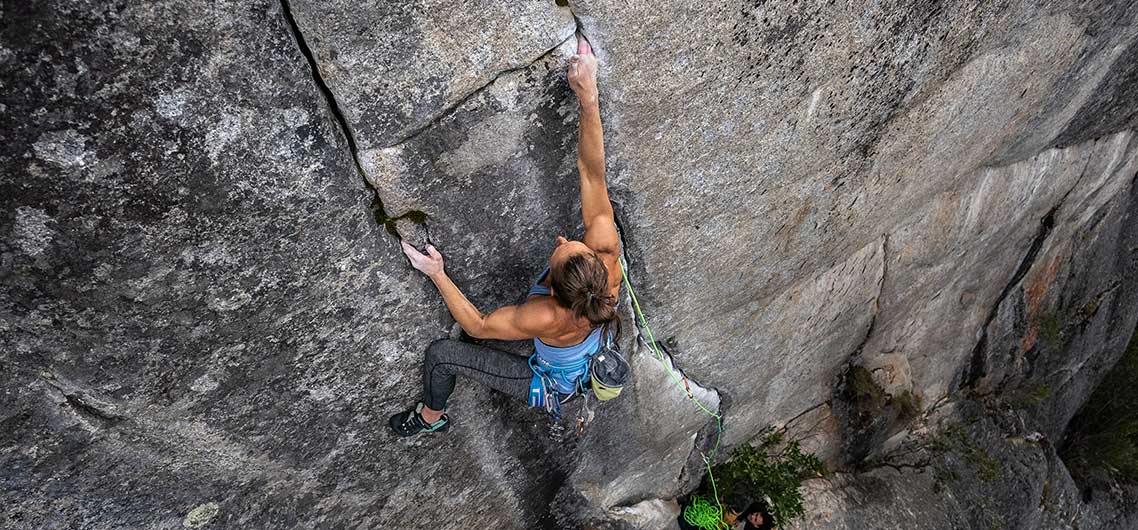Fuel Your Body to Climb Your Best
07-08-2022
Underfueling hinders performance and negatively impacts health
Amity Warme

Originally posted by SCARPA
Underfueling prohibits you from meeting your potential. It limits your physical and mental capacity to work, to train, and to perform. As athletes, we strive for peak performance and flawless physique. In many sports, carrying extra weight is a disadvantage. The problem arises, however, when athletes mistakenly prioritize low body weight and leanness while neglecting the role of food as fuel for optimal performance, growth and development, and long-term health.
Do you:
- Train hard but fail to see results commensurate with your effort?
- Experience chronic fatigue or difficulty completing intended workouts?
- Get sick often?
- Struggle with recurring or frequent injuries?
- Have difficulty building strength or gaining muscle?
- Feel like you recover slowly after training, climbing, skiing, running?
- Miss menstrual cycles or have decreased sex drive?
- Have a negative or complicated relationship with food?
Read on to learn more about the detrimental effects of underfueling and how to recognize RED-S and the corresponding impact on your health and performance.
What is Relative Energy Deficiency in Sport (RED-S)?
RED-S refers to the impairment of physiological functioning and athletic performance caused by low energy availability (LEA). It is a fundamental mismatch between the amount of energy consumed relative to the amount of energy expended through physical activity. RED-S is most prevalent in athletes participating in weight sensitive sports such as climbing and distance running. Both males and females can experience RED-S through either intentional under-eating or an inadvertent calorie deficit.
Energy Output > Energy Intake = Low Energy Availability
How does RED-S develop?
Your body requires energy for everything it does – breathing, normal cell turnover, regulating body temperature, circulating blood, etc. Simply existing requires energy (calories) from food intake. Your basal metabolic rate (BMR) refers to the baseline number of calories your body needs to maintain functioning if you were lying in bed completely still all day. Activities of daily living – walking, cooking, cleaning, talking, thinking, digesting – require additional energy.* Engaging in exercise – climbing, running, skiing, hiking, etc. – further increases your body’s energy needs. Subtracting the energy used in exercise from your total energy intake gives us your energy availability (EA).*
The exact EA needed to maintain health and performance varies widely from one individual to another depending on body composition, age, gender, and metabolism. If EA falls below the minimum amount, your body enters a state of low energy availability. At this point your body goes into energy saving mode. Picture a cell phone with low battery that turns off background apps to conserve energy. The problem? These background functions (hormone levels, immunity, bone density, and more) are essential to your long-term health.
Signs, symptoms, & performance consequences of RED-S:
RED-S may manifest in different ways for each individual and one can easily fall into a vicious cycle. An athlete may restrict food intake to lose weight, but over time their metabolism slows down to conserve energy. Weight loss and body composition changes stagnate. The athlete may interpret this as not restricting enough or not training hard enough and double down on their efforts, thus perpetuating the issue. An athlete struggling with RED-S may have trouble objectively assessing their condition, so it is important to be aware of the following signs, symptoms, and performance consequences in yourself and those around you.
- Fatigue
- Recurring illness and infections
- Low bone density
- Depression, irritability, and mood swings
- Irregular menstrual cycles
- Decreased sex drive
- Excessive weight loss
- Gastrointestinal upset
- Disordered eating patterns or thoughts
- Sleep disturbances
- Decreased growth in adolescents • Low energy
- Decreased muscle strength
- Decreased endurance capacity
- Increased risk of injury – bone and tendon
- Decreased glycogen stores
- Decreased coordination and concentration
- Inability to build muscle or strength
- Slowed metabolism
- Loss of training time due to injury or illness
- Lack of energy to complete intended workout
- Inability to recover after training
We all want to find the silver bullet that leads to improved sport performance. It is easy to get caught up in the mentality that simply losing weight is the answer. It may even seem to work for a short time. Eventually, however, the consequences associated with chronic underfueling will play out and both your health and performance will suffer.
Recovering from RED-S:
Eating enough calories to match your energy demands is critical. If you think you may be experiencing RED-S, work with a sports dietitian to determine the underlying cause of your underfueling. Disordered eating and intentional food restriction commonly lead to RED-S but many athletes under-eat inadvertently. Maybe you are too busy, too tired, don’t feel hungry, want to lose weight, want to look a certain way, or want to perform better, but underfueling your body can have serious consequences. Instead of subscribing to the idea that being a better athlete requires commitment to dieting, chronic calorie restriction, and continual weight loss, let’s think of food as fuel. Don’t limit yourself by not fueling properly. Adequate energy empowers you to pursue the activities you love, maximize your potential, and perform at your peak.
Total Daily Energy Expenditure (TDEE) includes:
- Exercise
- Varies by: intensity, duration, body weight, genetics
- Non-exercise activity thermogenesis (NEAT)
- Includes: activities of daily living (cooking, cleaning, gardening), fidgeting, etc.
- Thermic effect of food (TEF)
- Varies by: amount and composition of food consumed
- Basal metabolic rate (BMR)
- Varies by: weight, age, gender, body composition, hormones
Energy availability reflects the number of calories remaining after subtracting calories burned in exercise from total calorie intake and is expressed in terms of kcal/kg of lean body mass.
My story navigating RED-S:
I love trying my absolute hardest. I love digging deep, tapping the last reserves, and emptying the tank as I push myself physically and mentally on the rock. In 2017 I committed more fully to the adventure life and threw myself whole-heartedly into climbing – seeking continual improvement and dedicating days on end at the crag. I started consciously restricting the type and amount of food I ate in order to become leaner, lighter, and, in my mind, a ‘real climber.’ Rest days weren’t allowed as I strove to constantly perform at my peak. I deeply enjoyed this high energy output and dedication to craft – I still do – but for a time, it came at the expense of my long-term health.
In 2019, a DXA scan showed that both my body fat percentage and bone mineral density were extremely low. Short-term, I was increasing my risk for stress fractures, illness, anemia, and fatigue. Long-term, I was increasing my risk for more severe complications, including osteoporosis, infertility, and more. I had fallen prey to the idea that I needed to lose weight in order to perform better. I restricted my food intake, telling myself I was just eating “healthy” while I continued to increase time in the gym and on the rock. Admittedly, however, I was tired all the time, slightly irritable, rigid in my routine, and lacking the pep in my step that was characteristic of my chronically over-stoked personality. Despite my relentless effort to improve performance, I failed to see commensurate results.
The truth of the matter, put simply – I was chronically underfueling my body. Many of my symptoms were characteristic of RED-S. I didn’t understand that the mismatch between my energy intake and output was harming my health and hindering my performance. As my nutrition awareness grew, I began making changes to my dietary habits. These days I ensure that my food intake matches my energy output. And I pay attention to warning signs that I may be underfueling:
- Lack of psych to train or climb
- Feeling exhausted after training or climbing
- Overall low energy or fatigue over several days
- Feeling impatient or irritable
- Constantly thinking about food
- Slow recovery
A 2021 DXA scan showed that both my body fat percentage and bone density had increased. I am still on the lower end of bone density for my age, but no longer dangerously so. I am still in the midst of the process, but I am consciously working to shift my perspective. Rather than viewing calories in a negative light, I see food as the fuel that empowers me to accomplish my goals. I am intentional to:
- Eat a wide variety of foods that meet my nutrient needs
- Consume protein throughout the day to support muscle growth and repair
- Fuel with carbohydrate rich foods before, during, and after exercise
- Enjoy the social aspect of eating without taking myself too seriously
Without proper fueling I couldn’t have sent Freerider and Golden Gate this spring. I wouldn’t have had the juice to tackle alpine objectives in Rocky Mountain National Park and my days in Indian Creek wouldn’t be packed with pitches. Now, instead of worrying about micromanaging my diet, I focus my energy on exploring the limits of my capabilities and giving it my all.
Connect with me:
If you have questions or comments, please feel free to reach out to me through the site or on Instagram @amity.warme. I would be happy to answer questions or point you toward additional resources.
Powerful stories of other climbers dealing with and recovering from RED-S:
- Mina Leslie-Wujastyk
- Jasna Hodžić, PhD
- Delaney Miller
- Light Documentary featuring Emily Harrington, Angie Payne, Kai Lightner, and others
